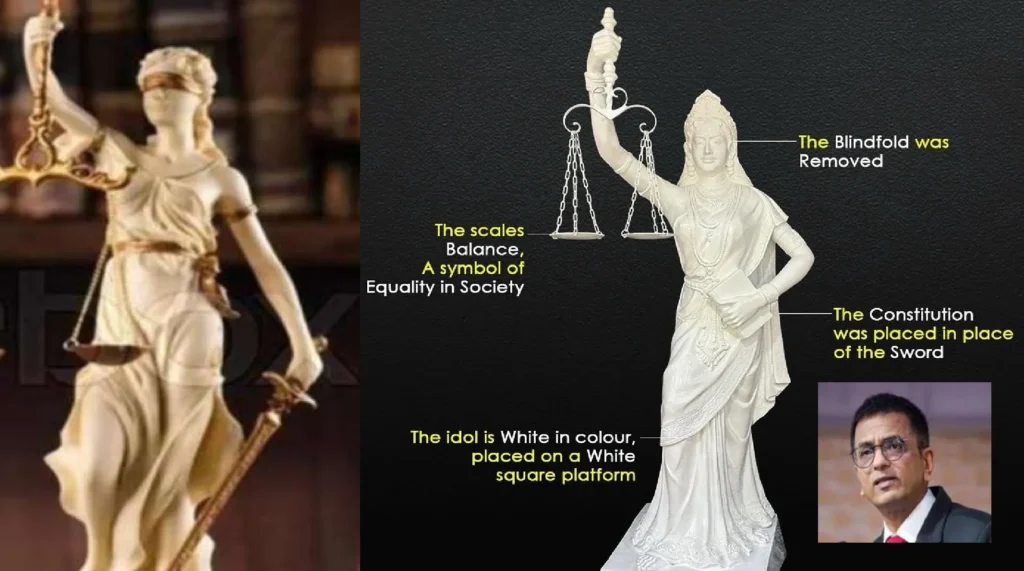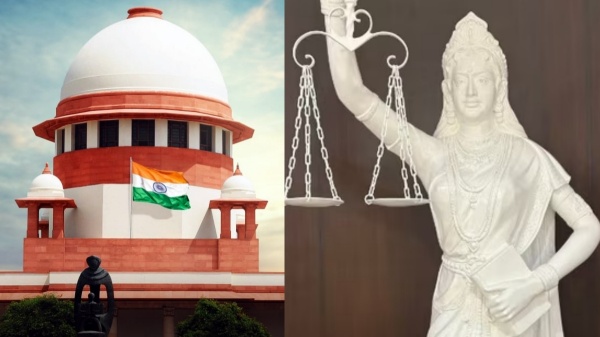Since the 16th century, the statue of Lady Justice, with a blindfold, holding an unbalanced scale in one hand and a sword in the other, existed in every court of India. It represented the impartiality of justice. This was originally introduced by the British Raj. Recently, the statue of Lady Justice was replaced with a new one by a commission led by Chief Justice of India D.Y. Chandrachud.
The Story Behind Lady Justice
The figure of Lady Justice originates from ancient Greek and Roman iconography. She is believed to be the allegorical personification of the law and the moral force that drives society. In ancient Greece, Themis was a Titaness, often depicted with scales and a sword. She was associated with divine law and moral justice. Themis was one of the 12 Titans born to Gaea and Uranus according to the works of the Greek poet Hesiod, who lived circa 700 BCE. She is known as the goddess of justice, wisdom, and good counsel.
The worship of Lady Justice was first introduced by Roman Emperor Augustus, who considered justice one of the most important virtues to uphold.

Significance
- Blindfold: Symbolizes the impartiality of justice. It signifies that justice should be administered without bias, treating everyone equally regardless of wealth, power, or social status.
- Toga: Represents the philosophical attitude of the Greco-Roman world.
- Sword: Symbolizes authority and power.
- Scales: Represents weighing evidence from both parties in disputes.
Read this also: One Direction Star Liam Payne Dies at 31: Tragic Fall Shocks Fans
Introduction in India
Although Lady Justice depicts justice, morality, and equality, the scenario in Indian history is a bit different. In India, the traditional Lady Justice statue is a reminder of the years of colonial legacy, as it was introduced by the British Raj during their rule. The commission proposing the new statue, led by Justice Chandrachud, is seen as an attempt to leave behind India’s colonial legacy as the country steps into a new era with the Bharatiya Nyaya Sanhita.

During the colonial period, the British introduced their legal system to establish control and supremacy over India. One of the British legal system’s most enduring legacies in India is the hierarchy of courts, while the Indian Penal Code introduced by the British was only recently replaced by the Bharatiya Nyaya Sanhita. The Indian system is now making efforts to remove the scars and marks left by colonial rule.
New Lady Justice
On Thursday, the Supreme Court revealed the new six-foot-tall version of Lady Justice. The new Lady Justice comes with many changes and incorporates elements of Indian culture. The major changes include the removal of the blindfold, replacing the sword with the Constitution, and balancing the scales. The commission that designed the statue states that the traditional blindfold was removed to symbolize that “law is not blind” but rather “sees everyone equally.”
Read this also: 16th BRICS Summit: Modi’s Strategic Diplomacy, Ukraine War Talks, and BRICS Expansion
The sword was replaced because it was seen as a symbol of violence, while the Constitution represents justice through a legal framework rather than punishment. The statue now wears a saree instead of the traditional western attire, representing India’s cultural identity.
Why Change?
The new take on the statue, designed by Vinod Goswami, a muralist who teaches at the College of Art in Delhi, comes in the wake of legal reforms such as the new criminal codes and the stated aim of “decolonizing” the legal framework in India. The change was initiated to create a distinctive Indian identity in the legal system by removing British symbols.

By replacing the sword with the Constitution and removing the blindfold, it shows that modern Indian justice is not about punishment but about ensuring fairness and equality based on constitutional values. This change is part of a larger effort to modernize India’s legal system while maintaining the core principle that justice should be balanced and fair for all.
Let’s hope that the change in the figurine will also be reflected in the Indian judicial system, ensuring fairness and equality are indiscriminately established across the nation.









[…] Read this also: Indian Courts Unveil a New Lady Justice Statue Embracing Cultural Identity […]
[…] Read this also: Indian Courts Unveil a New Lady Justice Statue Embracing Cultural Identity […]